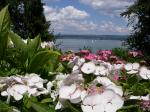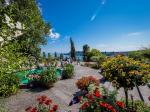Gardens of the Middle Ages
Charlemagne made the beginning...
With the departure of the Romans it seems that the history of horticulture at Lake Constance ends at the first glance. But the impression is deceiving.
A monk from Lake Constance preserves antique garden knowledge
The remaining Celtic-Roman population maintains their customs. Not only the viniculture survives but also the memory of the country estates gardens. Charlemagne gave her around 800 in his "estates regulation" a shape. However flower gardens aren't mentioned in the script. Ancient knowledge about horticulture is as well recorded in written form on the Island of Reichenau. Walahfrid Strabo, the later abbot of the island monastery, describes in a poem ("Hortulus", around 820) the garden and field work of his time. He is listing 24 plants, which were cultivated in his monastery garden. A reconstruction of the garden from Walahfrid Strabo can be visited at the Island of Reichenau (D).
Also developed on the Island of Reichenau: The Saint Gall monastery plan
It is no surprise, that also a monastic ideal plan (so-called "St. Galler Klosterplan", around 820) was developed at the Island of Reichenau and is kept safe in Saint Gall. This plan preserved in many areas the ancient heritage of horticulture. On a visit in the Abbey library of Saint Gall you will stand in amazement before the monastery plan. Saint Gall as well as the Island of Reichenau belong to the UNESCO- World Heritage Sites.
A few hundred years later: Gardens just for the senses
A first pleasure garden of the Post Classic period describes the Dominican friar Albertus Magnus, from Lauingen at the Danube, in the 13th century. He is well known at Lake Constance and also consorts in the monasteries on Lower Lake. In his treatise about plants describes Magnus a garden that serves exclusively the senses: a meadow square with a fountain in the middle, surrounded by fragrant plants and lawn benches.
Parks as a status symbol
This idea picks Pietro de Crescenzi in his writing about agriculture (around 1304) up and extends it to gardens for the middle-class and the nobility. His work has been often translated till the 17th century and is considered one of the most important writings for horticulture in Europe. Valuable exemplars are preserved in e.g. Thurgauer cantonal library (CH-Frauenfeld) and in the library of Heinrich Suso Gymnasium (D-Constance). They come from the possession of later dissolved monastery our region. As in the Roman period the gardens developed in the late Middle Ages into a status symbol of the high society. Who possessed rank and name or came into money, bought a country estate not far away from his hometown. There he settled for construction and created a garden.
To fall in love with a patrician garden
A great example offers the "Narrenberg", not far away from Constance (today CH-Arenenberg). Today mostly known as exile seat of Bonaparte, but the "Narrenberg" had also a great significance in the Middle Ages as country estate for important dynasties on Lake Constance. You will find on the site at a historical location the reconstruction of such a medieval patrician garden according to the instructions of Albertus Magnus and Pietro de Crescenzi.





 deutsch
deutsch







